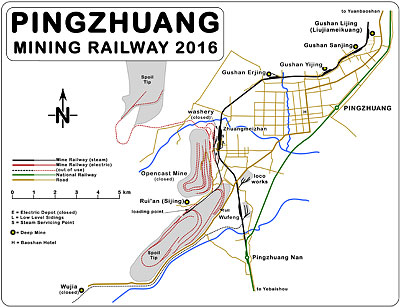THE END OF THE LINE?
searching out the last industrial steam before it disappears
China - 12 November to 3 December 2016 - Report by Duncan Cotterill
INTRODUCTION
The steam age is rapidly coming to an end in China but, even at the end of 2016, there was just enough activity to justify another visit. As usual I travelled with Peter Breeze and Sun Xiaolan. This report covers our three week trip to Pingzhuang, Wujiu and Sandaoling in late November and early December and includes some diesels and electrics as well as steam.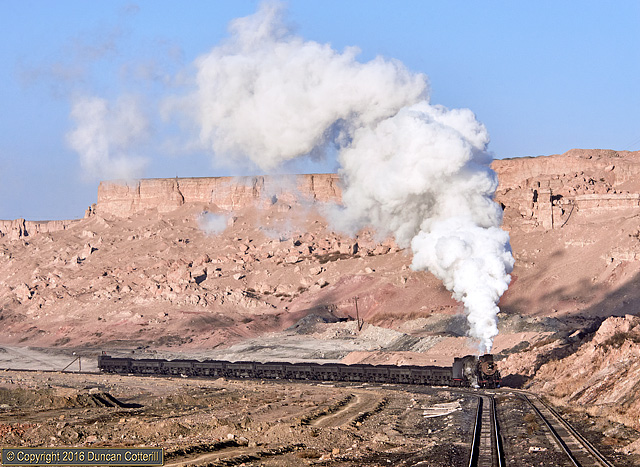
Reason To Return
Why go back to China after so many trips and with so little steam left?The answer is simple, Sandaoling. While those grimy JS 2-8-2s continue to battle their way out of the opencast pit it will always be worth another trip. This is real railroading with big engines, frequent trains, steep gradients, towering exhausts and lots of noise. Once it’s gone there will never be anything else like it, anywhere, ever again. That seems a good enough reason to me.
JS 8225 made heavy weather of the climb with the first daylight train on 1 December 2016, down to walking pace and slipping repeatedly as it struggled to keep moving.
HOME TO PINGZHUANG
Sat 12 to Sun 13 November 2016We flew from the UK to Beijing via Helsinki with Finnair but the journey wasn’t as uneventful as usual. They’d overbooked economy class on the flight from Helsinki and we couldn’t get seats when trying to check-in online 36 hours before departure. It eventually turned out that the flight wasn’t overbooked and all they had to do was shuffle some people into empty seats in business class to make room for us scum at the back. However they didn’t tell us that, adding more than a day of unwelcome uncertainty into the equation. Then, at Helsinki, less than an hour before the booked departure time and just as we finally got our seats allocated, an unspecified delay was announced.
We eventually left 3hr30 late and made up a whole five minutes on the way to Beijing. At least the formalities were completed quickly and, within an hour of arrival, we were through immigration, had collected our bags, changed money, met Xiaolan and our driver and left by road for Pingzhuang.
The route was via Chengde to Pingquan on the expressway and then a rather slow cross-country route to Pingzhuang. Nothing of railway interest was seen en-route, apart from construction work for the Beijing – Chengde – Fuxin – Shenyang high-speed line. We had hoped to spend a couple of hours on the railway at Pingzhuang but the late arrival at Beijing put paid to that idea. It was dark by the time we arrived at our base for the next four nights, the Baoshan Hotel in the centre of town.
The Pingzhuang Lottery
Will it be steam or diesel? You never know until you get there. Whatever mix of traction you get, there won’t be a lot of trains. Pingzhuang has never been busy and is even quieter since the washery closed.DF4.1251 crawled through Zhuangmeizhan with a loaded coal train from Lijing Mine to the CNR interchange at Pingzhuang Nan on 17 November 2016, passing SYs 1425 and 1764 stabled at the servicing point. This was the only train on the system all day and the SYs did no work at all.
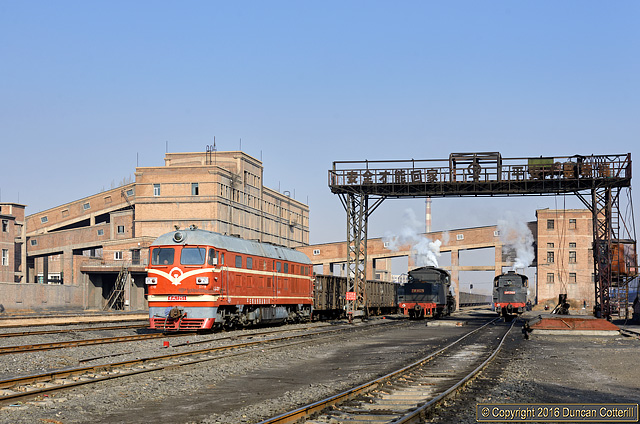
PINGZHUANG MINING RAILWAY
Mon 14 to Thu 17 November 2016Over the past couple of years Pingzhuang has been all steam, all diesel or a mixture of both, seemingly at random. During our visit this time, two SYs and a DF4 were in use each day. SY 1425 and SY 1764 worked for the whole period but DF4 6087 was swapped with DF4 1251 on the afternoon of 16 November. The spare diesel appeared to be kept in a shed in the low level compound at Zhuangmeizhan.
Most trains between Pingzhuang, Zhuangmeizhan and Lijing were diesel worked but on three occasions one of the SYs made a trip to Pingzhuang Nan to deliver loads or collect empties. Only one steam working was seen on the line to Lijing over the four days we were in the area.
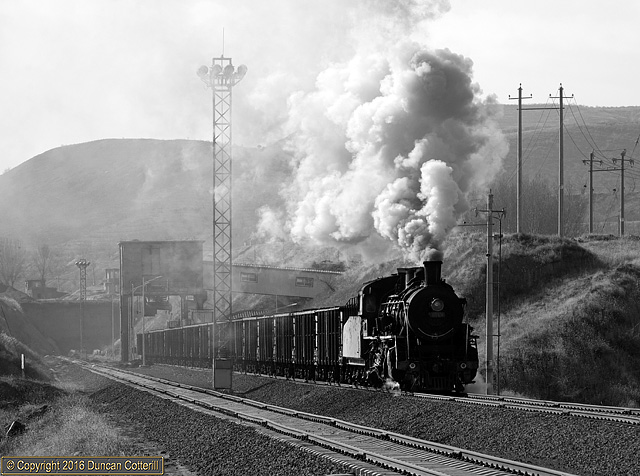
Rui’an Departure
We’d hoped to get an early morning departure from the new mine at Rui’an but the line was closed for track work one morning and there were problems with the loader the following day, delaying the trains until the middle of the day when the light was less than ideal.SY 1764 put a bit of effort into getting its train on the move from the Rui’an loader at lunchtime on 16 November 2016.
High Line Drifter
Once loaded trains reach the end of the sidings at Rui’an, its downhill all the way to Zhuangmeizhan so the loco lets gravity do all the work.Thankfully SY 1764’s firemen had just fed the fire when the loco drifted past with ten loaded wagons, late on the afternoon of 14 November 2016.
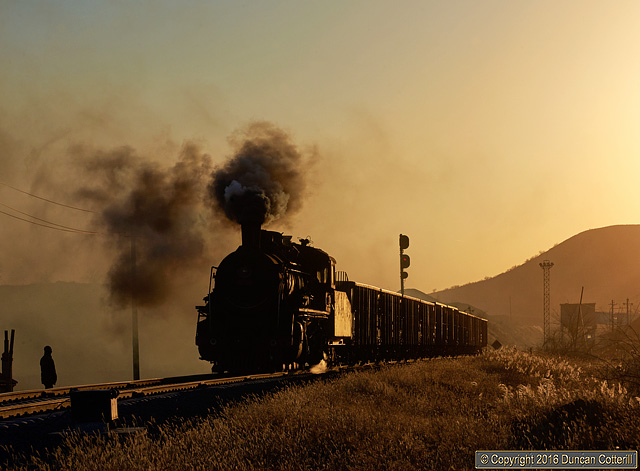
Most steam activity was concentrated on the line from Zhuangmeizhan to Rui'an, also known as Sijing or Mine 4. This is the new mine on the southern rim of the old opencast pit and feeds a loading point a few hundred metres away via a conveyor. The line climbs steeply, all the way from the junction at Zhuangmeizhan, and only levels off at the mine itself. It’s difficult to accommodate trains of loads and empties at the mine simultaneously, so normal practice during our visit was for a light SY to run to the mine, collect the loaded wagons and then haul them to Zhuangmeizhan, chimney first. Shortly after the loads reached Zhuangmeizhan, the other SY would set off with empties and haul them up to the mine, leave them at the loader and then return light engine. Wagons were positioned under the loader by a winch so a loco didn’t have to be in attendance continually.
In total we saw three sets of loads leave Rui’an and three sets of empties arrive but traffic wasn’t as heavy as it could have been due to various periods when the loader wouldn’t work or was inaccessible due to track work. On the final day the mine was closed altogether for a safety inspection and no loading was taking place.
The closure of the washery at Zhuangmeizhan has left the deep mines at Lijing (Lujiameikuang) and Rui’an as the only significant sources of coal on the line. Pingzhuang was never busy and, with less coal being produced and the diesel doing its share of the work, the steam locos spent most of their time at the Zhuangmeizhan servicing point. To be fair, the diesel spent a lot of time there as well and duties seemed to be shared fairly equitably between diesel and steam. In reality, a single loco, steam or diesel, could have handled all the work on offer during our visit and having three locos in daily use seemed extravagant.
In total we saw three sets of loads leave Rui’an and three sets of empties arrive but traffic wasn’t as heavy as it could have been due to various periods when the loader wouldn’t work or was inaccessible due to track work. On the final day the mine was closed altogether for a safety inspection and no loading was taking place.
The closure of the washery at Zhuangmeizhan has left the deep mines at Lijing (Lujiameikuang) and Rui’an as the only significant sources of coal on the line. Pingzhuang was never busy and, with less coal being produced and the diesel doing its share of the work, the steam locos spent most of their time at the Zhuangmeizhan servicing point. To be fair, the diesel spent a lot of time there as well and duties seemed to be shared fairly equitably between diesel and steam. In reality, a single loco, steam or diesel, could have handled all the work on offer during our visit and having three locos in daily use seemed extravagant.
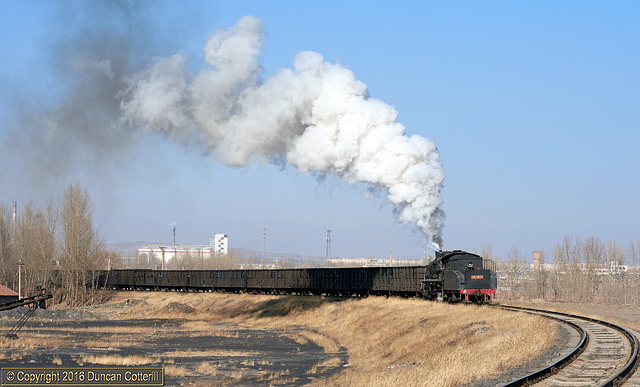
Backwards And Upwards
Every train of loaded wagons we saw leaving Rui’an was followed by a train of empties going to the mine. The line climbs steeply all the way from the junction at Zhuangmeizhan to the end of the sidings at the mine, where it levels off. Unfortunately all the locos run tender first uphill.SY 1425 dragged a string of empty coal wagons up the hill to Rui’an on the afternoon of 16 November 2016.
Waiting At The Workshops
DF4 1525 and SY 1441 were safely tucked away in a shed in the workshop complex, along with SY 1487. The SYs appeared to be serviceable but the diesel clearly hadn’t moved for a long time, as evidenced by the build up of debris on the cab roof. The picture was taken on 17 November 2016.Outside, three more SYs and a JS were dumped. It’s difficult to be certain because we couldn’t visit every corner of the site but all the other locos previously stored or dumped here, including the Yuanbaoshan JS, appear to have gone.
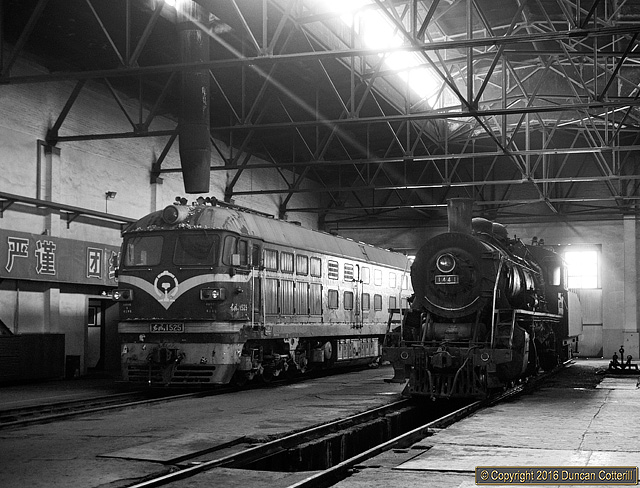
On the fourth day, with no prospect of getting either SY working, we decided to see if we could get into the works to see the locos there. This had always been "too difficult to arrange" in the past and we expected to be turned away this time as well. Surprisingly our request for a visit was agreed by the man at the gate and in we went. It was lunchtime and there was absolutely nobody around, which might have made our visit easier. Dumped SY 1017 and 1025 were outside and had clearly been stripped of some parts. Nearby were derelict SY 0798 and JS 1001. The two spare steam locos were inside a large shed, SY 1441, apparently in full working order, and SY 1487, undergoing minor repairs. Also present was DF4 1525, looking as if it hadn't been moved for a long time and with no indication whether it was operational. It's possible that there might have been more locos elsewhere on site. The shed we visited wasn't equipped to carry out the full overhauls previously mentioned in reports, so the workshop must be elsewhere on site and we didn't think it wise to push our luck by going looking for it.
Pingzhuang Locos
SY 1425, SY 1764, DF4 1251, DF4 6087 in useSY 1441, SY 1487, DF4 1525 cold, probably serviceable
JS 1001, SY 0798, SY 1017, SY 1025 dumped/derelict
Pingzhuang Map
The Pingzhuang map has been updated to show the new line to Rui’an as well as the closure of the branch to Wujia and the remaining electric lines in and around the opencast mine. The town is expanding rapidly so it’s probably out of date already. Click on the small map on the right to open a larger version in a new window.More maps of Chinese steam locations here. Sadly most are now only of historical interest.
CNR PINGZHUANG AREA
A few trains were seen on the main line while we waited for steam activity at Pingzhuang Nan or on the line to Rui’an. Freights were worked by HXN3 diesels and passengers by DF4Ds, either the original passenger machines or the DF4DK variant. Preparations for electrification were underway with many concrete masts erected alongside the line around Pingzhuang.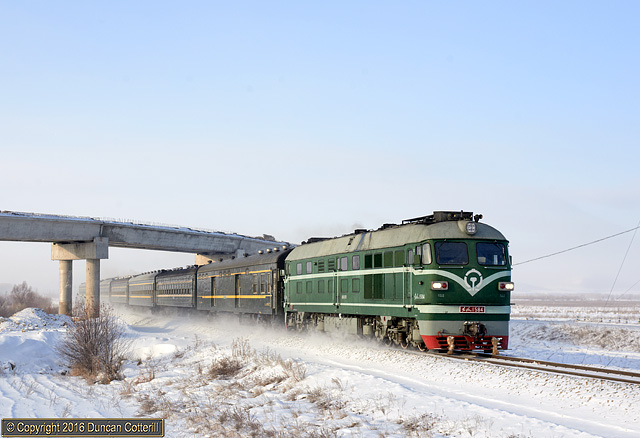
Diesels In Decline
The once ubiquitous DF4s are now almost as rare as the steam locomotives they replaced in the 1980s and 1990s. A number remain in CNR service in the Haila’er area but are unlikely to survive once electric working starts on the main line from Qiqiha’er to Manzhouli, displacing large numbers of modern diesels.DF4 1584 approached Meitian with train 4181/4184, the 06:12 passenger from Haila’er to Mangui, on 20 November 2016. Note the makeshift snow brushes and LED headlight.
PINGZHUANG TO WUJIU
Thu 17 to Fri 18 November 2016With no prospect of any afternoon action at Pingzhuang, we travelled to Chifeng by road in plenty of time for our overnight train to Yakeshi. In the past this might have been a dodgy move as the chances of getting soft sleepers from Chifeng on a Hohhot to Manzhouli train would have been slim. Fortunately the reservation system has improved and the required soft sleeper tickets were obtained without difficulty. Train K274/275 arrived at Chifeng behind DF4D 0308 and the same loco probably took us on to Tongliao. This line also appears to be undergoing electrification with masts seen at various locations east of Chifeng. Several DF4C, passenger DF4D and HXN3 diesels were seen around Chifeng. The station pilot was a DF5.
After a reasonable night's sleep, dawn broke somewhere well to the west of Qiqiha'er with snow on the ground and a DF11 on the front. Most other passengers were either DF4D or DF11 hauled and all of the many freights seen were worked by HXN5 diesels. The line is double track and electrified all the way to Yakeshi but the overhead equipment looked brand new and we didn't see a single electric loco anywhere.
West of Boketu the line climbs over the Dahinggan Mountains and freights were banked up both sides of the hill by more HXN5s. A single DF4B was seen dropping down to Boketu light engine, possibly after banking a freight to the summit, so the new locos might not have a monopoly of these duties. Another DF4B was seen at the summit on train 6238/6239, the 05:23 Haila'er to Taerqi passenger. There used to be a spiral on the westbound climb from Boketu but the line now follows a new route, north of the original, and the spiral is out of use. The rails were still in place close to the point where the old line would have rejoined the new route, just east of the summit tunnel, but the connection had been removed. A DF5 was shunting at Yakeshi, where we got off, while yet another DF4B waited with a welded rail train. Plinthed and freshly painted SY 0232 looked very smart in the station forecourt but was surrounded by parked cars and difficult to photograph.
Wujiu Arrival
SY 1225 rolled into Wujiu Yard with around 30 coal loads from the Sanjing (Mine 3) loading point east of town.This was one of only two daytime chimney-first steam workings during the five days we spent at Wujiu and both were downhill all the way. It even made Pingzhuang seem busy.
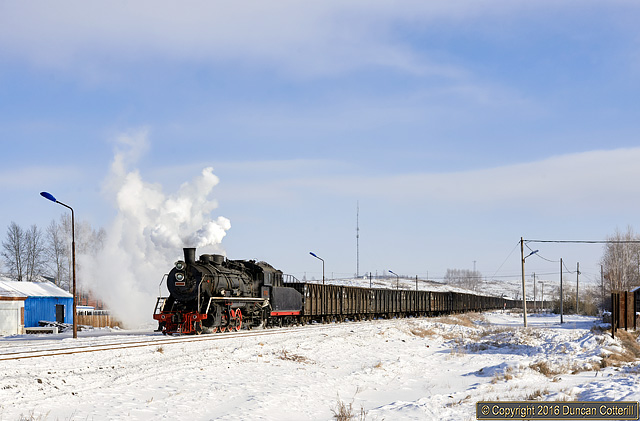
WUJIU MINING RAILWAY
Fri 18 to Tue 22 November 2016Wujiu is probably best described as having a lot of potential but not many trains. The area is very attractive, especially when blanketed in a few inches of snow and with a deep blue sky overhead. It's not spectacular scenically but the gentle hills, wide open spaces and birch forests do have a beauty of sorts, rather reminiscent of the area north of Nancha, for those old enough to remember it. This is Siberia, in all but name, with weather to match. Temperatures dropped well below -30C overnight and rarely got above -15C during the daytime. Fortunately the clear air and blue skies more than compensated for the cold.
The railway connects four mines around the town of Wujiu with CR's Yakeshi to Yitulihe line at Meitian, 57 km north of Yakeshi.
Yikuang (Mine 1), north-east of Wujiu, is closed, although it’s still rail connected and the steam locos go there to be coaled by a front end loader.
Erkuang (Mine 2) is actually alongside the line west of Wujiu, on the way to Meitian, where the SY Country maps show “coal loading” or “Shengli Mine”. It does appear to produce coal but none of it was being shipped out by rail during our visit.
Sikuang (Mine 4) is the large modern mine south of Wujiu, shown as “new mine” on one of the SY Country maps, but isn't currently working and we were told that it hasn't shipped out any coal by rail since Spring Festival 2016. It is expected to resume production sometime and, we were told, will be steam worked when shipments restart.
That left Sankuang (Mine 3), about 3km east of Wujiu, as the only place loading coal during our visit. The loading point is some distance north of the mine and shown as “No 2 mine (disused)” on one of the SY Country maps. It used to be connected to the mine by a narrow gauge electric railway but coal is now moved in lorries. Loading is by front end loader but, with up to four in use at any one time, around 8 to 10 wagons could be filled in an hour.
Wujiu has four operational locomotives, three SYs and a diesel, DF4DD 0288. Only one of the SYs was in use during our visit, SY 1225. Both it and SY 1134 were in excellent external condition with shiny paintwork and brass numberplates. SY 1564 wasn't quite as clean but a good session with an oily rag would have been enough to sort it out. The locos spent most of their time tucked up in the shed, close to the west end of Wujiu Yard, and only ventured out when there was work for them to do.
Keeping Warm
After bringing a loaded train down from Sanjing, SY 1225 headed to the shed for a rest. It was 11:50 on the morning of 22 November 2016 and the day’s steam activity had just come to an end.DF4DD 0288 had to come out of the shed briefly to allow the SY to enter. It would then follow the steamer inside for a couple more hours in the warm before taking the loads to the CNR interchange at Meitian during the afternoon.
Both locos seemed to spend as much time as possible inside the shed and only came out when there was work to be done.
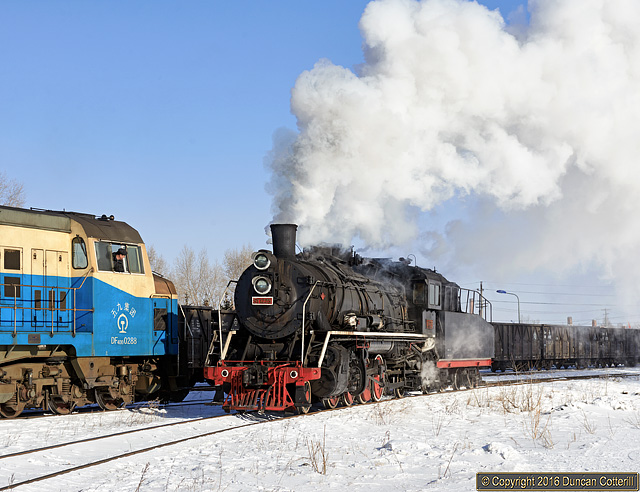
We spent five days at Wujiu but only saw activity on four of them.
On the first day we arrived from Yakeshi just before midday to find the diesel going back to the shed light engine after delivering loads to Meitian. By the time we'd had a look at the lines to Mines 3 and 4, the shed was locked up and the staff had all gone home. Nothing else happened all day.
We were advised to make an early start the next morning and left the hotel at 06:30. Arriving at Wujiu just before 07:00, we found SY 1225 bringing 10 loaded wagons down from Sankuang, still in semi-darkness. The diesel took them to Meitian while the SY serviced and went back to the shed, joined by the diesel shortly after 09:00. That was it for the day.
On day three nothing moved all day.
On the first day we arrived from Yakeshi just before midday to find the diesel going back to the shed light engine after delivering loads to Meitian. By the time we'd had a look at the lines to Mines 3 and 4, the shed was locked up and the staff had all gone home. Nothing else happened all day.
We were advised to make an early start the next morning and left the hotel at 06:30. Arriving at Wujiu just before 07:00, we found SY 1225 bringing 10 loaded wagons down from Sankuang, still in semi-darkness. The diesel took them to Meitian while the SY serviced and went back to the shed, joined by the diesel shortly after 09:00. That was it for the day.
On day three nothing moved all day.
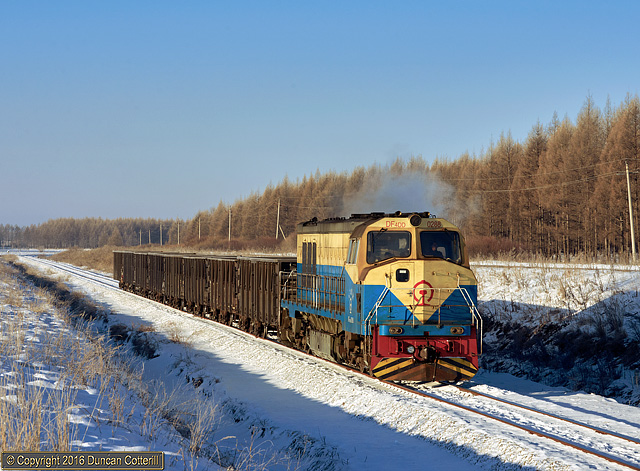
Steaming Diesel
One of the most remarkable sights of the trip, unfortunately not captured photographically, was DF4DD 0288 producing billowing clouds of steam as it emerged from the shed into the cold morning air on 22 November 2016. By the time the diesel had been to Meitian to collect some empties the effect was fading but the loco was still steaming gently on the return to Wujiu.Condensation must have built up inside the loco while it was in the shed with SY 1225 and, as the engine warmed up, the water evaporated again and was expelled by the cooling fans, creating the steam cloud.
Day four held more promise as 66 empties had been requested from CR. We arrived at Wujiu before dawn to find the diesel running round 30 empties in the yard, which it then propelled to Sankuang before returning to the shed for shift change. Shortly after 08:00, SY 1225 appeared and ran light to Sankuang before bringing back the loads at 10:30. Unfortunately the line is downhill all the way and the loco didn't have to work at all, even to get the train started. After that, the steam loco was serviced and went back on shed. In the afternoon, the diesel took the loads to Meitian but found no more empties to collect. The crew told us that there was a possibility of more wagons being delivered around 18:00, well after dark, but, if they didn't appear, the loco would go back to Wujiu light engine in time for the 20:00 shift change.
Another 66 wagons were requested for day five and eight empties were delivered to Meitian before 08:00. The diesel collected them and brought them to Wujiu, arriving around 09:00. SY 1225 coupled up and propelled them to Sankuang, arriving before 09:30. This was the only uphill steam working during our entire visit but the drain cocks were open almost all the way, shrouding the loco in clouds of steam. Loading didn't take long and by 10:20 SY 1225 was trundling back to Wujiu with the loaded wagons. We expected the diesel to take them to Meitian but, apparently, it wasn't worth taking so few, so the SY propelled them up the Yikuang line before retiring to the shed just before 12:00. Once again, the additional empties requested didn't materialise and there was no more activity planned until after the evening shift change.
Another 66 wagons were requested for day five and eight empties were delivered to Meitian before 08:00. The diesel collected them and brought them to Wujiu, arriving around 09:00. SY 1225 coupled up and propelled them to Sankuang, arriving before 09:30. This was the only uphill steam working during our entire visit but the drain cocks were open almost all the way, shrouding the loco in clouds of steam. Loading didn't take long and by 10:20 SY 1225 was trundling back to Wujiu with the loaded wagons. We expected the diesel to take them to Meitian but, apparently, it wasn't worth taking so few, so the SY propelled them up the Yikuang line before retiring to the shed just before 12:00. Once again, the additional empties requested didn't materialise and there was no more activity planned until after the evening shift change.
Steam In The Freezer
Snow on the ground, frost on the trees, deep blue skies, clear sunlight and a cold so intense that it hurt. Perfect conditions to photograph steam engines in other words.SY 1225 prepared to couple up to the empty wagons that the diesel had just brought up from Meitian on the morning of 22 November 2016. The departure of the train was nothing like as satisfying to photograph with the loco propelling and the drain cocks open all the way to Sankuang.
Wujiu came close to producing some exceptional photographs but sadly not quite close enough.
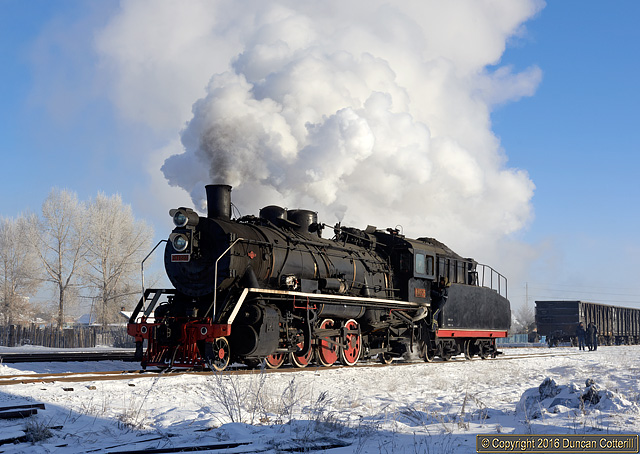
Wujiu's operations appeared to require empty wagons to be available in the Yakeshi / Haila'er area at relatively short notice and it seemed that there were never enough of them. Whenever empties were available, they were quickly worked to Sankuang, filled and sent back to CR, leaving the line with no wagons and the engines with no work until some more empties arrived at Meitian.
Like Pingzhuang, Wujiu could easily handle all the traffic on offer with a single loco. A second engine might be required if Sikuang was to restart production, assuming there were enough wagons available to run any trains! The line from Sikuang appeared to be fairly level with some photographic potential. Loaded trains would be chimney first and hopefully have to work to the junction with the Meitian line.
Tourist facilities in the nearby town of Wu'erqihan were surprisingly good. We stayed at the Liyuan Hotel at the east end of the town, in a nice quiet area that appeared to be recently developed but was still within a few minutes walk of several excellent restaurants. The hotel itself was simple, clean and comfortable, with all the usual facilities including WiFi. It was also warm, important when it's minus thirty something outside. I don't think I've ever described a Chinese hotel room as stylishly decorated, and probably never will, but this place came fairly close. Although much smaller and well off the tourist trail, even Wujiu had some decent restaurants, perfectly capable of knocking out a bowl of hot noodles and a spicy maladofu, just the ticket when you've been out in the cold for an hour.
While at Wujiu we were driven by Mr Xiao, as recommended by John Athersuch (Nov 2015 report on SY Country). I can heartily endorse John's recommendation, as we couldn't have hoped for a more knowledgeable and helpful driver, without whose assistance we'd have struggled to get the few good shots we did actually achieve.
SY 1134 (Tangshan 1981/5), SY 1546 (Tangshan 1987/5) cold, probably serviceable
Like Pingzhuang, Wujiu could easily handle all the traffic on offer with a single loco. A second engine might be required if Sikuang was to restart production, assuming there were enough wagons available to run any trains! The line from Sikuang appeared to be fairly level with some photographic potential. Loaded trains would be chimney first and hopefully have to work to the junction with the Meitian line.
Tourist facilities in the nearby town of Wu'erqihan were surprisingly good. We stayed at the Liyuan Hotel at the east end of the town, in a nice quiet area that appeared to be recently developed but was still within a few minutes walk of several excellent restaurants. The hotel itself was simple, clean and comfortable, with all the usual facilities including WiFi. It was also warm, important when it's minus thirty something outside. I don't think I've ever described a Chinese hotel room as stylishly decorated, and probably never will, but this place came fairly close. Although much smaller and well off the tourist trail, even Wujiu had some decent restaurants, perfectly capable of knocking out a bowl of hot noodles and a spicy maladofu, just the ticket when you've been out in the cold for an hour.
While at Wujiu we were driven by Mr Xiao, as recommended by John Athersuch (Nov 2015 report on SY Country). I can heartily endorse John's recommendation, as we couldn't have hoped for a more knowledgeable and helpful driver, without whose assistance we'd have struggled to get the few good shots we did actually achieve.
Wujiu Locos
SY 1225 (Tangshan 1983/5), DF4DD 0288 in useSY 1134 (Tangshan 1981/5), SY 1546 (Tangshan 1987/5) cold, probably serviceable
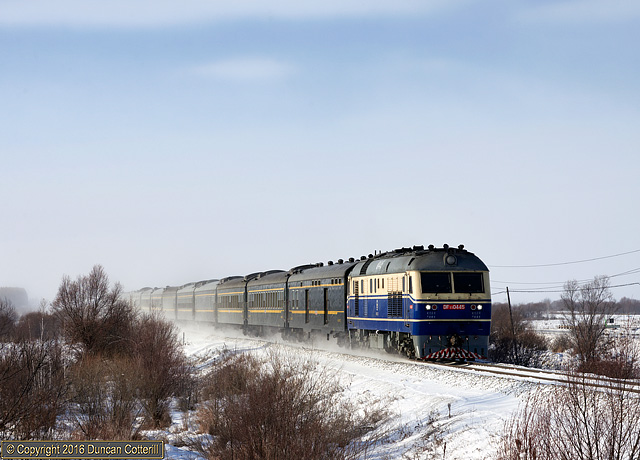
Take The Long Way Home
Train K7094/K7095 doesn’t take the most direct route between Haila’er and Harbin but runs north from Yakeshi to Yitulihe then east to Jiagedaqi and south through Nenjiang to Qiqiha’er before rejoining the main line. This turns a 10 hour, 680km journey into a 25 hour 1160km ordeal. Bet there aren’t many passengers who go the whole way.Harbin allocated DF11 0445 approached Meitian with K7094/ K7095 just after 10:00 on the morning of 20 November 2016, stirring up the snow. It would be 08:30 the following morning before the train reached its destination.
CNR YAKESHI - YITULIHE LINE
With long quiet periods at Wujiu, and the confidence that there would be no action until more empty wagons arrived, we spent some time at Meitian, observing operations on the CR line from Yakeshi to Yitulihe. This route forms part of a long loop into the far north of Nei Menggu and Heilongjiang with branches reaching even further north, almost to the border with Russia. The area is sparsely populated and has a correspondingly sparse passenger service with long gaps between trains. Four different passenger services were seen, one of them on three occasions and the others only once each. The fast trains were worked by DF11s but the only ordinary passenger seen had a DF4B in charge. Only two freights were seen. On our second day an HXN5 arrived from the Yakeshi direction light engine and then returned south with the coal wagons left by Wujiu's diesel. On the fourth day another HXN5 was seen heading north with a short freight at Wu'erqihan around 06:30 in the morning, probably the same train that dropped off the 30 empties for Wujiu at Meitian.American Freighter
HXN5 0015 set out from Meitian on 19 November 2016 with a string of loaded coal wagons delivered earlier by Wujiu’s DF4DD.The HXN3 and HXN5 diesels marked a major change in China’s locomotive development policy in being joint ventures with the major American manufacturers, EMD and GE respectively. The HXN5 is a GE ES59ACi rated at 6250HP and built by Qishuyan under licence since 2008. The class works much of the freight traffic on the busy Manzhouli - Harbin - Mudanjiang axis in north-eastern China.
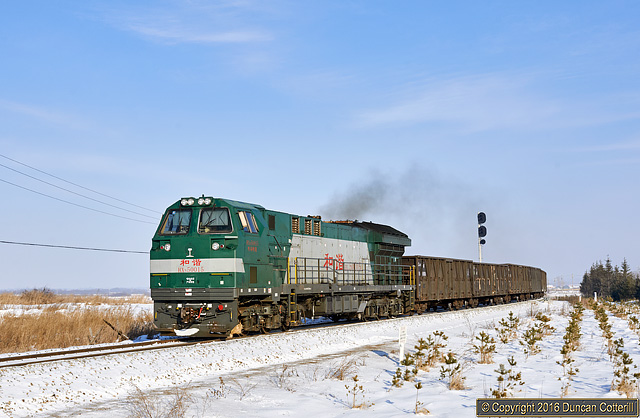
WUJIU TO BEIJING
Tue 22 to Wed 23 November 2016From Wujiu our driver took us to Haila'er Airport by road, a journey of around 2hr30min but we weren’t in a hurry and didn’t take the most direct route. On the way we saw a couple of freights with HXN5s and a passenger with a DF11, all west of Yakeshi. Electrification appeared to be complete as far as Haila'er but, again, no electrics were seen.
There were two scheduled flights from Haila'er to Beijing on the day we travelled, one departing at 23:30 and the other at 23:35, so we had a very long day. Despite our Air China flight departing 15 minutes early, it was still well after 02:30 before we got to the Capital Airport Hotel at Beijing.
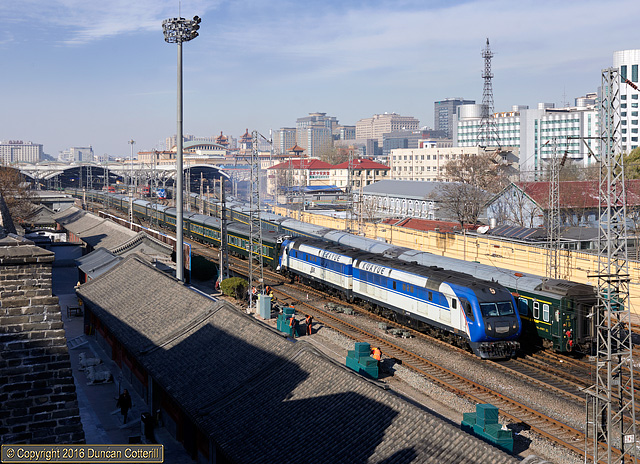
Diesel Under The Wires
DF11G 0007 and 0008 set off from Beijing with train Z205/Z208, the 18:38 from Changsha to Tianjin, on 23 November 2016. A few years ago it was common for diesels to haul passenger services for long distances under the wires as there was a shortage of electrics geared for express passenger speeds. That no longer seems to be the case.Rather unusually this train runs into Beijing from the south, changes locos and then heads south-east to Tianjin. This strange routing is probably due to the shortage of rolling stock servicing facilities in the Beijing area rather than any passenger requirement.
CNR BEIJING
Wed 23 Nov 2016We had a day in Beijing between our early morning arrival from Haila'er and our early morning departure the following day to Hami. A couple of hours were spent at the Dongnan Jialou, overlooking the approach to Beijing station. Trains from the south were heavily delayed and arrived with their bogies encrusted in snow and ice so what we saw might not be representative of a normal day.
Most passengers were electrically hauled. The most common class seen was SS9G, which handled almost half the trains observed. A handful of early SS9, HXD3C and HXD3D worked most of the remaining passengers and a couple of CRH5A high-speed EMUs were also seen, including one on a service to Qiqiha'er.
Diesel haulage of long distance services under the wires continues but is nothing like as common as it once was. A pair of DF11Gs arrived with train Z205/Z208 from Changsha, handing over to another pair to take the train on to Tianjin. Train 6452 from Yangcun, was worked by a standard, and rather scruffy, DF11 instead of the hoped for DF10F. Train T66 from Nanjing was very late arriving so we didn't see what took the stock to Qinhuangdao, a DF11Z turn for the past couple of years. However a DF11Z pair did emerge from the bowels of the station and go to shed light engine shortly after we arrived, so they are still around.
Back To The Sidings
SS9G electrics worked almost half the passenger services we saw from the Dongnan Jialou on the morning of 23 November 2016, including Z140, the 18:22 from Nantong. Beijing normally gets the newest and most capable locomotives and I was expecting to see more HXD3Ds than SS9Gs but that was not the case.SS9G 0187 backed the empty stock for Z140 out towards the carriage sidings 25 minutes after arrival. Note the ice and snow on the leading coach.
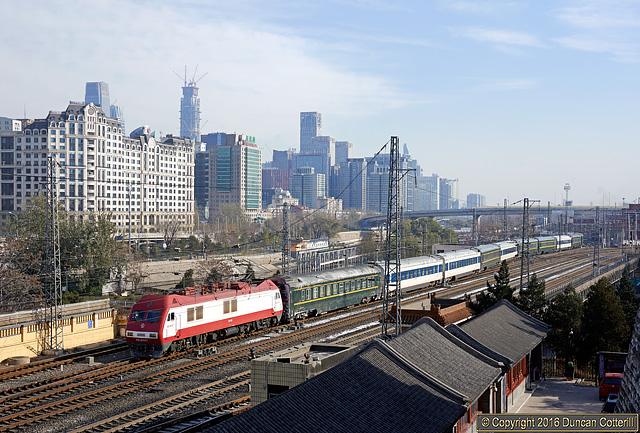
BEIJING TO SANDAOLING
Thu 24 November 2016We took the usual morning flight from Beijing to Hami, arriving just before midday, and were met by Gu Li and our driver at the airport. The journey to Sandaoling was a bit slower than in previous years as we took a diversion via the back roads and Liushuquan to avoid paying the toll on the expressway. Given the small fortune we'd had to pay Gu Li for our trip to Sandaoling, it was a bit galling to find our time being wasted to save a handful of RMB. However, it was lunchtime, so we probably didn't miss much as a result and were still at the lineside shortly after 14:00. Unlike previous trips, this time we stayed at the Longmen Hotel, at the northern end of town and quite a bit better than the usual establishment halfway down the main street.
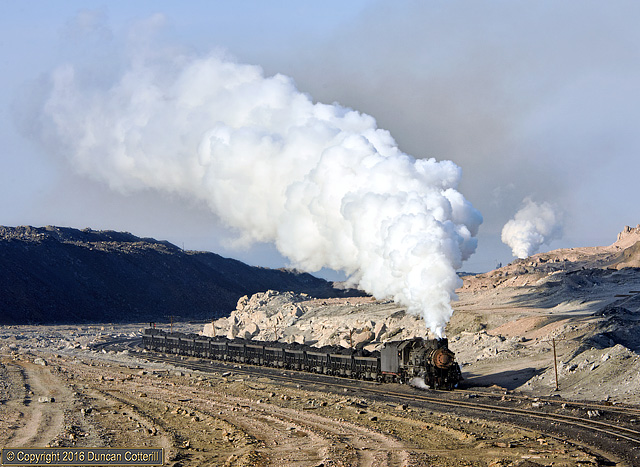
Exhausting
After hanging around for hours at Pingzhuang and Wujiu, waiting for not much to happen, Sandaoling was a welcome relief with frequent trains and plenty of noise and exhaust from the hard working locos. It was also physically demanding with lots of brisk walking and climbing required to get to the right place in good time to photograph the next train.JS 8167 was going well as it climbed from Ba’erzhan with a loaded train on the morning of 1 December 2016. The next train was close behind, requiring a very rapid change of location before JS 8190 flew past, just eight minutes later.
SANDAOLING MINING RAILWAY
Thu 24 November to Thu 1 December 2016Very similar to last year but, if anything, a bit busier in the opencast mine. Five different JSs were seen in action in the pit during our visit, JS 8081, 8167, 8190, 8197 and 8225, but there were never more than four locos in use on any one day and on two days there were only three. JS 8081 was only active for the first three days and JS 8225 for the last four days. The others worked for the whole period, except for JS 8197, which had a day off on 28 November.
The shift change at Dongbolizhan was similar to last year but the loco on "passenger duty" often left between 08:30 and 08:35, just a light engine these days, with the passengers riding in the cab. Instead of simply leaving Dongbolizhan and running into the pit, the passenger loco would always stop after around 100m to pick up passengers. If the last train to leave the washery was still in the reversing siding, it would stop there to deliver the new crew as well. The last train in to Dongbolizhan rarely arrived after 08:40 and the first set of empties would usually leave for the loader shortly after the passenger engine returned around 09:00. On one occasion there was a loaded train present at shift change and it continued to the unloading point at Jianmeixian afterwards, rather than the washery.
Morning Arrival
JS 8197 drifted into Dongbolizhan with its train of side tippers at 08:30 on the morning of 26 November 2016. This was the last train of empties to leave the Xuanmeichang washery before shift change and had been waiting at Kengkouzhan for a fresh crew to arrive before running into Dongbolizhan to be serviced and watered.Although sunrise was still half an hour away, the glow on the eastern horizon was just bright enough to illuminate the scene, with a little help from the yard lighting.
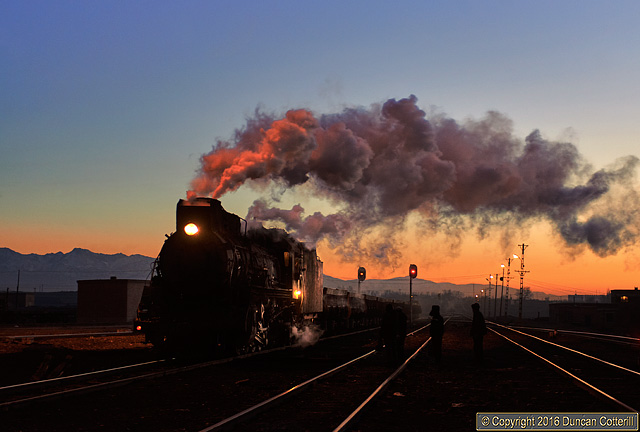
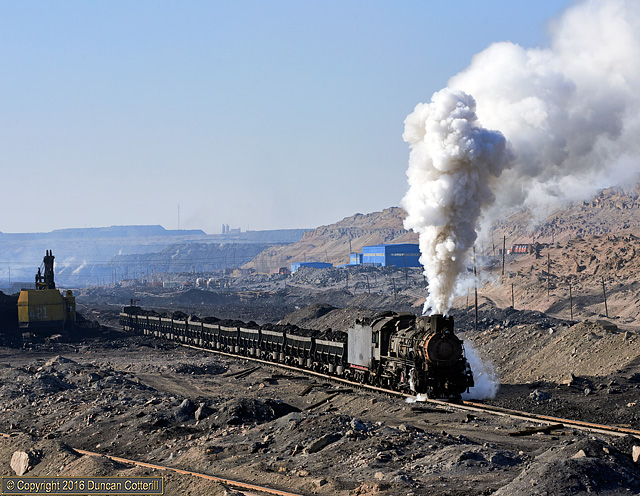
Slippery Customer
JS 8190 slipped violently as it eased its train away from the electric shovel at Xikeng on the afternoon of 26 November 2016. Almost every train to load here had the same difficulty and some skilled driving was required to get them moving.JS 8190 didn’t appear to be in the best condition when we arrived at Sandaoling but was descended on by a gang of fitters one morning at Dongbolizhan and put in some impressive performances after that.
The surviving locos are now approaching 30 years old and, with no overhauls for some time, it was surprising how well they coped in the arduous conditions.
Trains were loaded at three different locations between Ba'erzhan and Xikeng, the blue loading hopper and two spots on the second track from the south. At one spot a huge electric shovel could load a full train in 40 minutes but at the other a front end loader would take about 2 hours to do the same job. No trains were seen to use the northernmost or southernmost tracks but the rails were reasonably shiny on both lines, indicating that they were still in use. Trains loaded by the electric shovel tended to go to Jianmeixian and those from the blue loader and the front end loader to the washery. The coal going to the washery was noticeably finer than that going to Jianmeixian, which included some very large lumps. During the day around 40% of trains went to Jianmeixian but most of those between 17:00 and sunset seemed to go to the washery.
The first loaded train was often on its way out of the pit just after 10:00 and always by 10:45, a bit earlier than in previous years. There was also a lot more activity during lunchtime with no dead period of longer than 90 minutes and often no more than an hour without trains. Considering the period from 10:00 in the morning until we gave up each day, often well after 18:00, a total of 85 loaded trains were seen working out of the pit over 49 hours of observation, an average of one every 35 minutes. The best day was the Saturday with 16 trains out of the pit in 8 hours and the worst the Friday with 12 in a similar period. With loading taking place at two different locations simultaneously, trains didn’t run at regular intervals and there could sometimes be two loaded departures within ten minutes of each other. It paid to keep a very close eye on what was going on to avoid being caught out when changing location.
The first loaded train was often on its way out of the pit just after 10:00 and always by 10:45, a bit earlier than in previous years. There was also a lot more activity during lunchtime with no dead period of longer than 90 minutes and often no more than an hour without trains. Considering the period from 10:00 in the morning until we gave up each day, often well after 18:00, a total of 85 loaded trains were seen working out of the pit over 49 hours of observation, an average of one every 35 minutes. The best day was the Saturday with 16 trains out of the pit in 8 hours and the worst the Friday with 12 in a similar period. With loading taking place at two different locations simultaneously, trains didn’t run at regular intervals and there could sometimes be two loaded departures within ten minutes of each other. It paid to keep a very close eye on what was going on to avoid being caught out when changing location.
Jianmeixian Departure
JS 8190 left Jianmeixian after unloading its train on 30 November 2016. Around 40% of the trains from Xikeng didn’t go to the washery but continued to Dongbolizhan and then took the line that loops downhill, past the works, to Jianmeixian. Most of the coal transhipped there left Sandaoling in huge lorries but, intriguingly, some also appeared to be loaded into standard containers mounted on rail wagons.The store can be seen in the background, above the train, full of redundant steam locos, steam cranes and wagons, none of which are likely to work again.
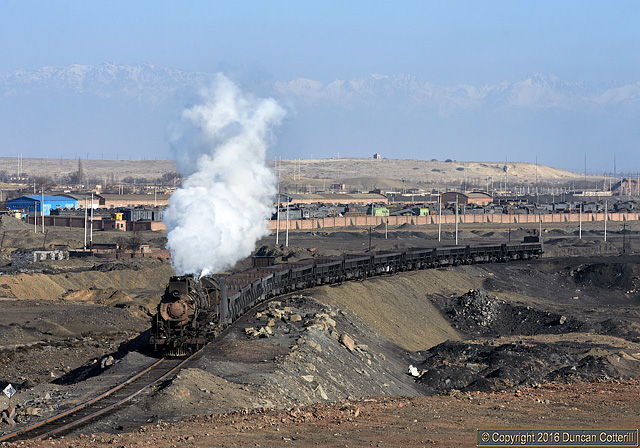
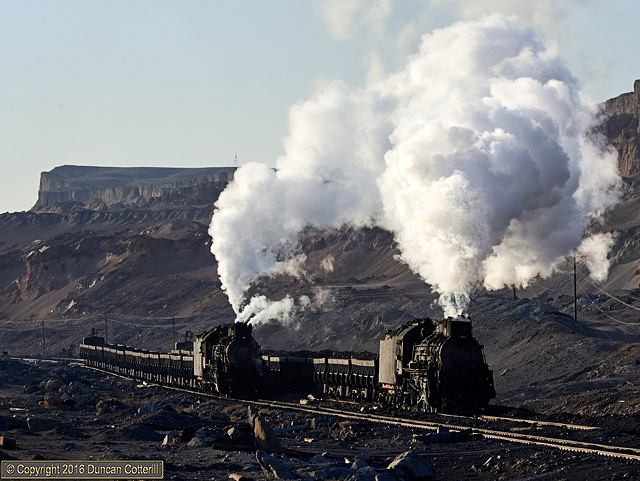
Coal Mine Main Line
With a double track railway overlooked by towering rock faces, Sandaoling sometimes looked more like a desert main line than a coal mine. The crews clearly thought they were on the main line and drove the locos suitably hard and fast.JS 8197 put on an impressive show as it accelerated a loaded train away from Ba’erzhan late on the afternoon of 26 November 2016. With 13 side tippers bucking and swaying behind the tender and a crisp exhaust echoing off the cliffs, it certainly looked and sounded the part.
On the other track JS 8081 prepared to push the next set of empties under the loader.
We spent a very limited amount of time on the system around Nanzhan but did manage to identify three of the locos working there, JS 8053, 8314 and 8366. A fourth loco was seen but not identified. On a couple of occasions we were aware of trains going to Erjing, either because we heard them or saw the exhaust in the distance, but we didn't think it worth investing the considerable amount of time required to get a shot of an operation that is predominantly chimney first downhill. We'd done way too much of that earlier in the trip and there was far more to be gained by concentrating on the opencast operation.
At least two of the diesels were in use but only DF8B 0250 was positively identified. At least one diesel hauled train was seen or heard either going to or coming from Shadunzi on most days. The only one we got a close look at was a 50+ wagon set of C70s that appeared to be on a dedicated circuit between Jiayuguan steelworks and mines in Xinjiang, according to the text on the wagons. Several trains to or from Liushuquan were also seen from a distance, again all DF8B hauled.
At least two of the diesels were in use but only DF8B 0250 was positively identified. At least one diesel hauled train was seen or heard either going to or coming from Shadunzi on most days. The only one we got a close look at was a 50+ wagon set of C70s that appeared to be on a dedicated circuit between Jiayuguan steelworks and mines in Xinjiang, according to the text on the wagons. Several trains to or from Liushuquan were also seen from a distance, again all DF8B hauled.
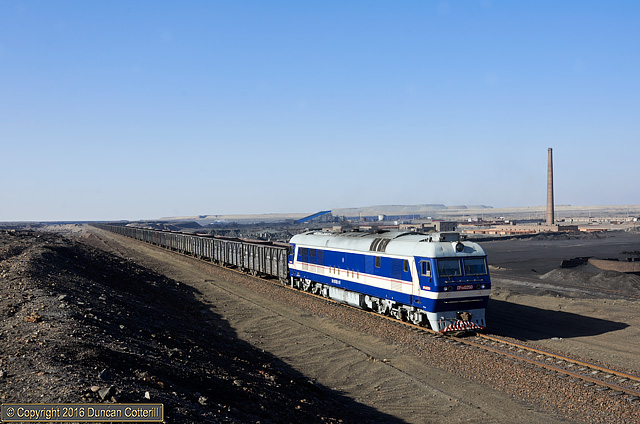
Shadunzi Diesel
The line between Nanzhan and the new deep mine at Shadunzi was the last great hope for steam but plans to use pairs of JS on the trains came to nothing and Sandaoling’s DF8Bs have worked the line almost from the day it opened in October 2014. We saw several trains going to or from Shadunzi during our visit and all were diesel hauled.DF8B 0250 rolled down the hill towards Nanzhan with a loaded coal train at lunchtime on 30 November 2016. The photo was taken where the line passes behind the Jianmeixian unloading point.
A Risky Position
JS 8190 dragged a loaded coal train up the last part of the climb out of the pit at Kengkouzhan on 29 November 2016.This was a risky place to take photos as there was a significant chance that the loco would shut off before reaching the optimum spot. Sometimes this was because the signal was red due to a conflicting move (with four trains in the system there were quite a few conflicting moves). On other occasions the loco was going so well that it could coast up the last couple of hundred metres with the regulator closed and drift over the top at walking pace.
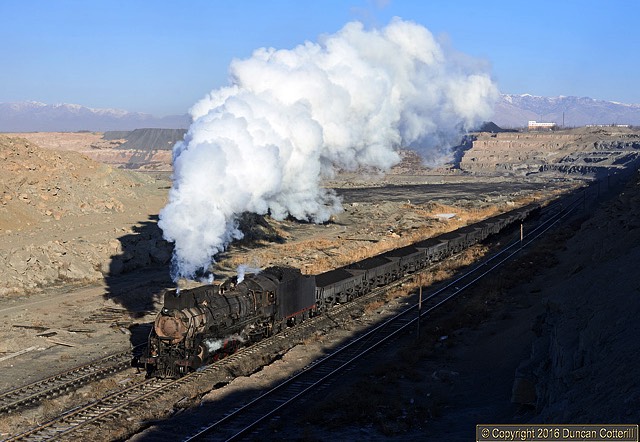
The latest information from Gu Li is that the opencast rail operation will end in May 2017 with lorries being used to extract the remaining coal from the opencast pit. Nothing said to us during our visit indicated that there was much chance of steam operation being extended beyond that date. There’s also the question of what will happen between now and May. Will the railway keep working at the current rate until the last day or will it gradually be phased out as the new lorries arrive or the coal from certain parts of the mine begins to run out? It was noticeable that the electric shovel was loading coal at a far faster rate than the pile was being replenished and, at the speed it was working, all the coal would be gone within a few weeks. That would mean a big reduction in the number of trains coming out of the pit unless there’s an alternative source somewhere.
It’s also been suggested that the steam operation at Nanzhan will continue, as now, for another couple of years with the JS working trains to and from Yijing and Erjing as well as shunting at Nanzhan itself. Again, nothing we heard contradicted that view. With four JS in daily use, it would still mean that Sandaoling has more steam activity than anywhere else in China.
JS 8053, JS 8314, JS 8366, DF8B 0250 plus another unidentified JS in use (Nanzhan)
numerous stored/dumped/derelict locos not checked
It’s also been suggested that the steam operation at Nanzhan will continue, as now, for another couple of years with the JS working trains to and from Yijing and Erjing as well as shunting at Nanzhan itself. Again, nothing we heard contradicted that view. With four JS in daily use, it would still mean that Sandaoling has more steam activity than anywhere else in China.
Sandaoling Locos
JS 8081, JS 8167, JS 8190, JS 8197, JS 8225 in use (opencast)JS 8053, JS 8314, JS 8366, DF8B 0250 plus another unidentified JS in use (Nanzhan)
numerous stored/dumped/derelict locos not checked
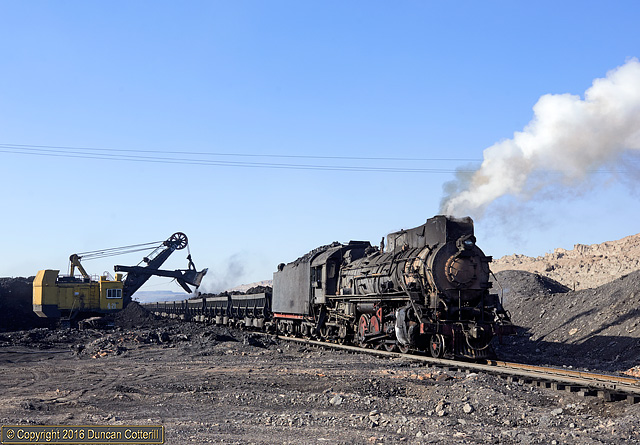
Moving Mountains
How long does it take to move a mountain? About 3 weeks judging by the rate at which the electric shovel at Xikeng was eating through the huge pile of coal next to the track.Every 40 minutes or so another few hundred tons of the black stuff would be shovelled into a waiting train and carried off, providing almost half the traffic we saw in the opencast mine. Very little new coal was added to the pile and it was unclear what would happen once it had all gone.
JS 8197 eased forwards as the shovel loaded its train at Xikeng on 26 November 2016.
SANDAOLING TO BEIJING
Thu 1 December 2016A very uneventful journey by minibus to Hami Airport and then the evening Air China flight to Beijing. The route was the same as the one we'd taken a week earlier but in reverse, including the diversion to avoid the road toll. The flight from Hami to Beijing was on time and we transferred to the CITIC Hotel by shuttle bus, arriving around 22:15.
No Room At The Museum
Every time I visit the Beijing museum the locos are crowded more closely together with less space to view them. The no climbing notices and yellow and black tape don’t look good either.JF6 3022 was squeezed in between the tender of SL 890 and a coach when we visited on 2 December 2016.
Some locos were even less visible with large displays in front of them preventing any view at all.
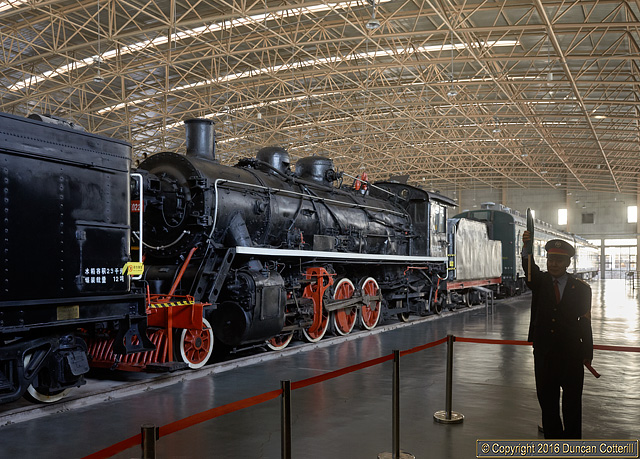
BEIJING RAILWAY MUSEUM
Fri 2 December 2016We travelled to the museum by taxi on the morning of 2 December. The driver didn’t have any idea where he was going but the maps.me app on my phone came into its own and allowed us do direct him there. The museum contained hardly anything that hadn’t been there on my last visit in March 2014. The steam exhibits were all the same and the only new diesels and electrics were a DF7, a DF7C, another SS3 (not even an SS3B) and a DF4B, all outside along with one of the JF11s. Inside, all the locos on most lines are now coupled together, making photography very difficult, and several engines were almost completely hidden behind other displays. The collection is still very unrepresentative with many one-offs, prototypes and duplicates, while some significant or widespread classes are still absent, particularly SY and JS'B'.
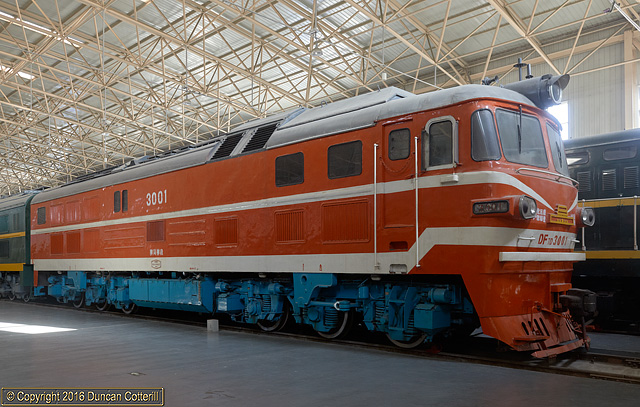
Duplicate Diesels
The DF7D was a main line version of Beijing Feb 7th Works’ standard heavy shunting locomotive. There were two variants, one for use on mountain lines with sharp curvature and the other designed to cope with extreme cold in the far north.Although over 200 were built, neither variant appeared to be successful and they were all withdrawn after a few years in service.
DF7D 3001 was in the museum on 2 December 2016, coupled to DF7D 0001. Both mountain variants of the class.
BEIJING TO HOME
Sat 3 December 2016Fortunately the return journey was a lot smoother than the outward one. The Finnair flight from Beijing to Helsinki was ready to go on time but it took an eternity to get to the runway. Arrival at Helsinki was a little late but still left plenty of time to make our connecting flights to the UK. Otherwise the main problem was boredom, particularly as the jet lag set in towards the end of the journey.
Pushing Back
JS 8190 pushed its train of empty tippers back towards the opencast pit after unloading at Jianmeixian at lunchtime on 30 November 2016. (right)The same loco had added its ash to the growing pile at the end of the headshunt a few minutes earlier. (below)
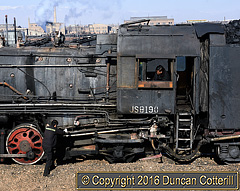
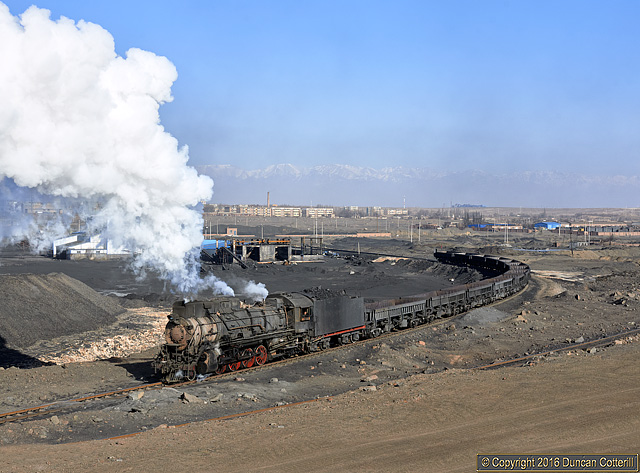
COMMENTS AND CONCLUSIONS
It was touch and go whether it would still be worth visiting China at the end of 2016. With only two locations in the whole country having enough steam activity to justify another trip, it wouldn’t have taken much to tip the balance against. In the event Fuxin went under, leaving Sandaoling as the only really good steam location to survive the summer. Confirmation that there were unlikely to be any significant changes there before the end of the year gave us the confidence to plan another trip.
The next question was whether it was worth going anywhere apart from Sandaoling. Pingzhuang was a fairly obvious choice as it wasn’t too far from Beijing and there was information that the diesels were out of use and it had returned to full steam operation. This turned out to have changed by the time we got there but we didn’t know that at the time. Of the other potential locations, Wujiu looked the most interesting and it was reasonably easy to get there from Pingzhuang and not too difficult to get back to Beijing afterwards.
I don’t regret going to Pingzhuang or Wujiu but neither really lived up to their promise due to the low levels of activity and the steam locos sharing what work there was with diesels. This in itself was a bit strange as, in most places in the world, the company would have either stuck with steam on economic grounds or, having bought a diesel, would have maximized its use and relegated steam to standby status at best. Using two locos and crews to do the work of one doesn’t seem to make economic sense but China has a very different business culture to the west and all sorts of factors influence what actually happens on the ground.
Sandaoling did live up to expectations, and some. What an incredible place – I’m still saying that after 9 visits over 11 years but every time I go back it surprises me just how good it really is. It’s partly the frequency of trains and partly the dramatic locations but mostly the way that almost every train is worked to the limit with a towering exhaust and lots of noise from the loco. The engines are filthy once again and most had a bad clank, particularly when running in reverse, but, despite their rundown condition, they were still up to the job.
The weather was pretty good throughout the trip. Over the past few years there have been some mild Novembers with a lot of cloud and higher than usual temperatures but this year was a much colder and clearer. There was a bit of cloud on a couple of mornings at Wujiu and a couple of half cloudy days at Sandaoling but that was all. It had sometimes been essential to stay close to the loader at Sandaoling during the afternoon on previous trips as the exhaust thinned to virtually nothing by the time the loco had warmed up. This time it was never necessary and full exhausts were maintained all the way to the top, even in the middle of the afternoon. All that was missing at Sandaoling was the snow and we only missed that by a day.
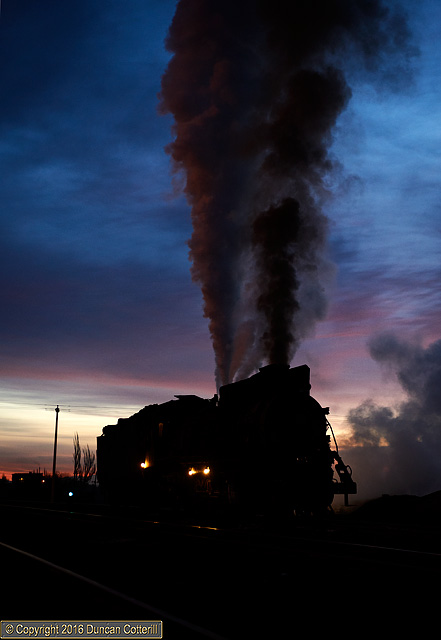
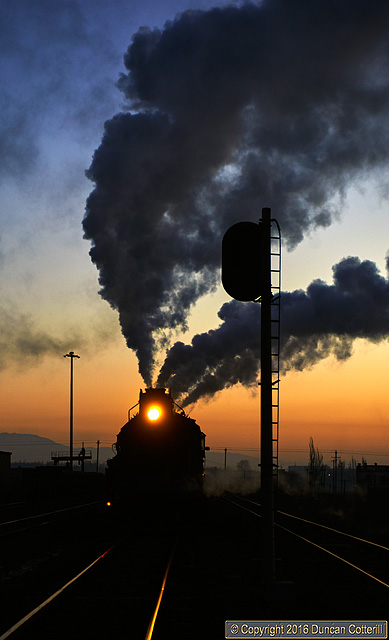
Dongbolizhan At Dawn
Every morning we would set out for Dongbolizhan in the dark, stopping only to pick up some baozi and nangs for breakfast. The locos were never stabled in exactly the same place and the light changed from one day to the next, meaning the photo opportunities were different every day. It wasn’t the easiest place to take pictures, stumbling around in semi-darkness, 30 minutes before sunrise, but some of the results were very satisfying. These two pictures of JS 8190 taken on 27 November and 1 December give some idea of the daily variation in colours and lighting. In the left hand image the loco was preparing to leave for Be’erzhan with the “passenger”, while on the right it sat in the yard with its train, waiting its turn to visit one of the lines with a water column.THE FUTURE
The opencast mine at Sandaoling is the last of the great industrial steam locations in China, indeed the world, and the current understanding is that it will close in May 2017. Road vehicles will be used to take out the remaining coal. That doesn’t leave a lot to base a future trip to China on.
The Sandaoling surface operation, based at Nanzhan, might still continue to use JS for a couple of years but isn’t particularly busy or photogenic and most of the chimney first movements are downhill. Pingzhuang and Wujiu have more photographic potential but at current activity levels don’t really justify a visit. All three locations have underutilised diesels that could handle all the work on their own, meaning that steam could finish at short notice, just like it did at Fuxin. Fushun, Jiutai and Tianjin just seem to have the lack of activity without the photographic potential.
There’s considerable pressure from the state to get rid of the remaining steam locos as soon as possible as they’re bad for China’s modern image and most railway bureaux won’t allow steam locos to enter their exchange sidings. Shenyang Bureau seems to be an exception to this with Pingzhuang’s SYs continuing to visit Nan on a regular basis. Local authorities also want to be seen to be doing something about air pollution and the steam locos are an easy target, despite the real problems being elsewhere.
There’s also the depressed coal price and the continuing development of massive, efficient, modern pits in previously undeveloped areas of Inner Mongolia and Xinjiang, making the smaller mines uncompetitive. In some cases the mines themselves are under threat as safety regulations are tightened and companies that can’t afford to meet them go out of business. Other mines just exhaust their economically recoverable coal reserves and close. It’s all pressure in the wrong direction for steam and means that none of the remaining operations have a secure future.
I’m not going to state categorically that this was my last trip to China for steam, as some others have done, but after 32 years and about 60 visits, it does look like it might have been the last one. Let’s hope I’m wrong and there’s something to go back for next year.
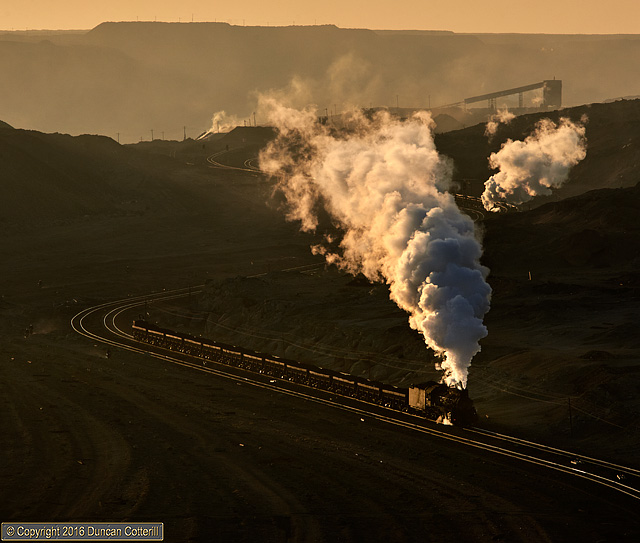
Sandaoling Sunset
The late afternoon light caught JS 8167 as it climbed out of the pit with a loaded coal train on 29 November 2016.It could be sunset for Chinese steam if the opencast operation closes in May 2017, as currently planned. Of the remaining steam lines, none come close in terms of activity levels or photographic potential, making a return trip look unlikely as this is written. It’s just not worth travelling halfway round the world to find an engine that might, or might not, shunt a couple of wagons around a factory yard.
If this trip does prove to be the last, then Chinese steam went out on a high note for me. So long Sandaoling, the world will be immeasurably duller without you.
THE END?
